This article was published in Scientific American’s former blog network and reflects the views of the author, not necessarily those of Scientific American
Squeakers or arthroleptids are a frog group of about 150 species* included within just 8 genera. All are endemic to sub-Saharan Africa, though one species – Leptopelis palmatus – occurs on the island of Principe and there are also species on Bioko and Zanzibar. The group takes its common name from the calls made by the Arthroleptis species, though they are sometimes also termed screeching frogs.
* It was 130 when I last wrote about the group, back in 2007.
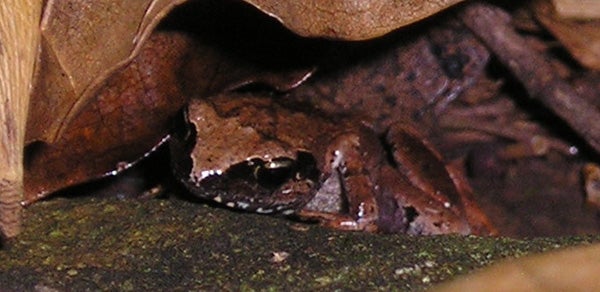
Wahlberg’s humus frog Arthroleptis wahlbergii. Credit: Serban Proches
On supporting science journalism
If you're enjoying this article, consider supporting our award-winning journalism by subscribing. By purchasing a subscription you are helping to ensure the future of impactful stories about the discoveries and ideas shaping our world today.
In general, squeakers are small, forest-floor frogs that lay their eggs in burrows or cavities in moist soil. Some are scansorial, some are highly aquatic stream-dwellers and Leptodactylon seems to spend most of its time beneath ground. In Arthroleptis and perhaps some Leptopelis species, direct development is present and a tadpole stage is skipped. The others do, however, have a tadpole phase. Body size is highly variable with some Arthroleptis species being just 15 mm long. At the other end of the scale, males of Trichobatrachus (discussed further below) reaches 130 mm. Yes, males – this is one of those weird frogs where males are larger than females.
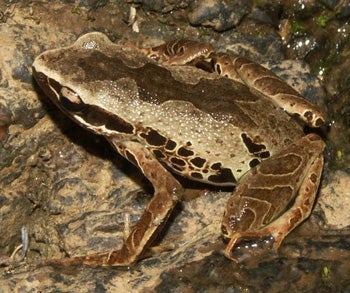
Silver long-fingered frog Cardioglossa leucomystax, though sadly without the long fingers being all that obvious. Credit: Václav Gvoždík
Squeakers tend to have vertical pupils, a rare character among neobatrachian frogs. An especially long third finger is present in the males of Arthroleptis and Cardioglossa, the latter sometimes being termed long-fingered frogs (Blackburn 2009). Glandular pads on the forelimb or chest are present in some Leptopelis species and nuptial pads are present on the hands of Leptodactylon, Astylosternus and others.
The unique Hairy frog. Probably part of the squeaker clade are the several taxa that used to be grouped together as the astylosternines or astylosternids. These are all tremendously obscure and poorly known, with the exception of Trichobatrachus robustus, the Hairy frog of tropical western Africa. Incidentally, this species was named (by legendary herpetologist George Albert Boulenger) in 1900 which is surprisingly recent for such a charismatic, famous and (reasonably) large amphibian. Then again, the Goliath frog Conraua goliath was named in 1906... also by Boulenger.
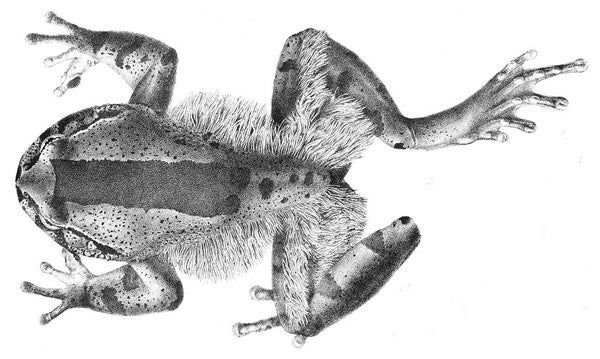
Fantastic 19th century illustration of male Trichobatrachus by J. Green. Credit: J. Green, Proceedings of the Zoological Society of London 1901
During the breeding season, males and males alone develop frills of hair-like papillae along their flanks and thighs (note that some authors of the past didn’t know that the papillae were unique to males and wrote of females possessing the structures as well). As many as 12 different hypotheses have been put forward as explanations for the evolution of these structures, but by far the most popular is that they might increase the animal’s surface area and thus allow more cutaneous respiration to take place, this then allowing it to remain submerged while it is egg-guarding. This was suggested by Dean (1912) among others, but he imagined that males somehow arranged the eggs around their papillae: quite how the male was supposed to get the eggs into position I’m not sure (Dean had midwife toads in mind, but they ‘only’ have to wrap egg strands around their hindlimbs).
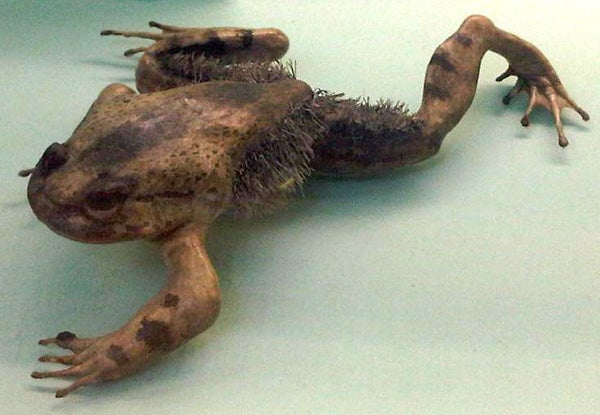
Taxiderm specimen of Hairy frog in the Natural History Museum, London. As is so often the case, I'm amazed by how little available (viz, CC) imagery of this species is available online. Credit: Emoke Dénes
More recently, Barej et al. (2010) proposed that the papillae evolved in step with the claws that these frogs possess and provide mechanical protection during mating battles. Claws?
Ah yes – claws. Hairy frogs are also weird in that they have claws on the second, third and fourth toes of their hindfeet (the presence of a claw on the fifth toe has been reported by some authors but seems erroneous). The Hairy frog is not unique in this respect: hindfoot claws are also present on the same toes of Astylosternus, and on the second and third toes of Scotobleps.
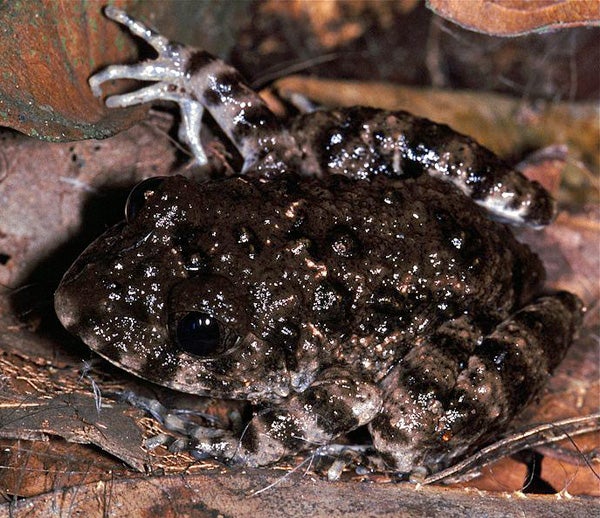
Gabon forest frog (Scotobleps gabonicus). Credit: Bernard Dupont
As is now relatively well known, these claws are not keratin-sheathed external elements (as is typical for amniotes) but hook-shaped distal phalanges that actually break away from an attached nodule and pierce the animal’s tissue when required (Blackburn et al. 2008). Yes, these are frogs that do a sort of ‘Wolverine thing’ when the time is right. Recent work on these claws has received a lot of media attention, popular articles including such terms as ‘superfrogs’, ‘wolverine frogs’ and ‘horror frogs’. As pointed out with some degree of curmudgeonity (is that a word?) by Barej et al. (2010), the presence and detailed anatomy of the claws has been known since Boulenger’s work. However, because individuals of some arthroleptid species were found with the claws still in their internal position while others had their claws exposed, ambiguity persisted as to the normal condition, let alone the way in which the claws were deployed.
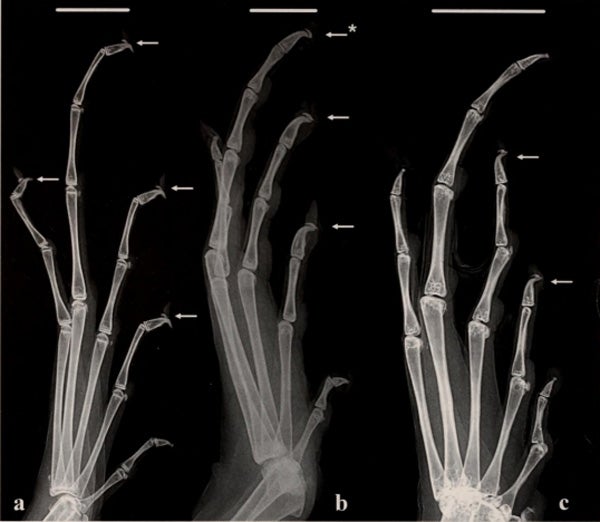
Claws visible on the hindfeet of (a) Astylosternus, (b) Trichobatrachus and (c) Scotobleps. Scale bar = 5 mm. Credit: Barej et al. (2010)
And what are the claws for anyway? The fact that individuals with scars and other wounds are known – Ivan Sanderson, Gerald Durrell and other zoologists and naturalists have noted these scars over the years – and that unsheathed claws can cut human skin support the idea that they evolved within the context of intraspecific combat (Barej et al. 2010), and in step with the dermal papillae and sexual size dimorphism.
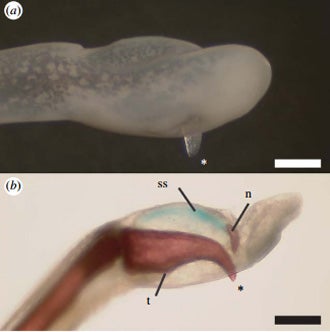
Fourth toes of Arthroleptis, showing (a) claw in unsheathed position; (b) in cleared and stained form, showing nodule and suspensory sheath that are attached to claw before it pierces skin. Credit: Blackburn et al. (2008)
One other interesting thing about these claws is that the arthroleptids that possess them are – apparently – not especially close relatives, there being clawless taxa between them in the phylogeny (Scott 2005). Does this mean that claws evolved once within Arthroleptidae and were then lost by several lineages independently, is it that claws evolved convergently a few times, or is it that the claw-bearing taxa are actually close relatives and those phylogenies depicting them as well apart are, actually, wrong? All possibilities persist right now (Barej et al. 2010).
And while there are a great many other things that can be said about arthroleptids, that is where we must stop for now. For previous Tet Zoo articles on anurans (that’s frogs and toads), see…
In pursuit of Romanian frogs (part II: WESTERN PALAEARCTIC WATER FROGS!!)
The toads series comes to SciAm: because Africa has toads too
North American spadefoot toads and their incredible fast-metamorphosing, polymorphic tadpoles
Frogs you may not have heard of: Brazil’s Cycloramphus ‘button frogs’
‘Strange bedfellow frogs’ (part I): rotund, adorable brevicipitids
‘Strange bedfellow frogs’ (part II): pig-nosed or shovel-nosed frogs, or snouts-burrowers
Refs - -
Blackburn, D. C. 2009. Diversity and evolution of male secondary sexual characters in African squeakers and long-fingered frogs. Biological Journal of the Linnean Society 96, 553-573.
Dean, B. 1912. On the hair-like appendages in the frog, Astylosternus robustus (Blgr.). Bulletin of the American Museum of Natural History 31, 349-351.
Scott, E. 2005. A phylogeny of ranid frogs (Anura: Ranoidea: Ranidae), based on a simultaneous analysis of morphological and molecular data. Cladistics 21, 507-574.